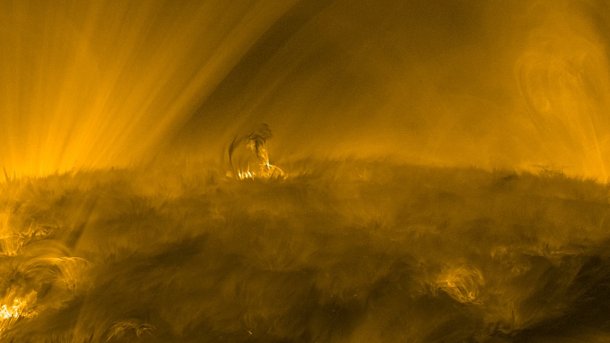Solar Orbiter: Stunning video reveals the sun's dynamic surface
SA's Solar Orbiter has taken a close-up image of the surface of the sun. It clearly shows how everything there is in motion and what structures there are.
(Bild: ESA & NASA/Solar Orbiter/EUI Team – CC BY-SA 3.0 IGO)
The European Space Agency has published an impressive image of the surface of the sun that shows the constant changes in the area where the corona begins. The short film was taken by the Solar Orbiter from a distance of several dozen million kilometers. It shows the region where the solar wind started, which reached NASA's Parker Solar Probe shortly afterwards. It passed by the sun at a distance of just 7.26 million kilometers, providing the perfect opportunity for this close-up, writes the ESA. The brightest regions that can be seen on it reach temperatures of one million degrees Celsius.
Empfohlener redaktioneller Inhalt
Mit Ihrer Zustimmmung wird hier ein externes Video (Kaltura Inc.) geladen.
Ich bin damit einverstanden, dass mir externe Inhalte angezeigt werden. Damit können personenbezogene Daten an Drittplattformen (Kaltura Inc.) übermittelt werden. Mehr dazu in unserer Datenschutzerklärung.
Those responsible at ESA have labeled various structures on the image of the infernal region to make it clear exactly what can be seen there. These include spike-like patterns of bright gas that appear at the base of large coronal loops, which are not shown here. Further back there are so-called spicules, very fast gas splashes that can be several thousand kilometers high. After a few seconds, a comparatively small eruption can also be seen, in which cooler material is ejected upwards before falling back down again. This "small" eruption is larger than our Earth. Finally, "coronal rain" consists of clumps of plasma falling onto the sun.
The Solar Orbiter was launched at the beginning of 2020 and has been orbiting our home star in ever-closer orbits ever since. However, it will not come as close to the sun as the Parker Solar Probe, which is on a similar mission and is supposed to come as close as 6.2 million kilometers to the star and even penetrate the coronal plasma. The smallest planned distance is 42 million kilometers (or 0.28 AU). At the same time, it was deflected strongly enough on several flybys, particularly of Venus, to be able to take the first images of the sun's poles in the future. In the fall of 2022, the probe was hit by an enormous solar flare near Venus.
(mho)
